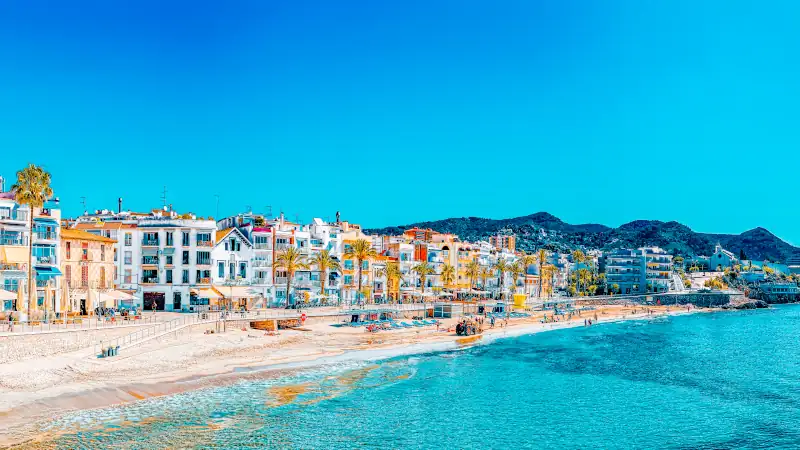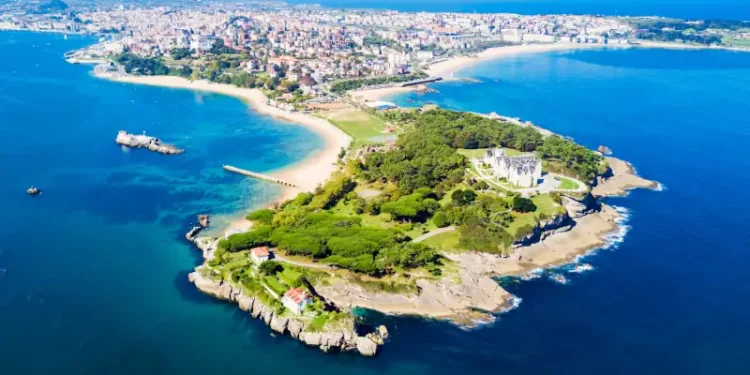Spain’s geography is as varied as her history. Filling most of the Iberian Peninsula—the closest U.S. state in terms of size is Texas—Spain boasts a dual-coastline. To the north is the Atlantic Ocean’s Bay of Biscay, to the south and east lies the Mediterranean Sea.
Home to more UNESCO Biosphere Reserves than any other country in the world, here you’ll find towering mountains, fertile lowlands, lush forests, rocky cliffs, and over 3,000 beaches, the longest of which is Andalusia’s Doñana Beach which runs for over 17 miles.
It’s even got a desert—Tabernas, the only true desert in Europe. Then there’s the islands… 48 of which are inhabited. The two main archipelagos are the Balearics and the Canaries. The Balearic Islands are in the Mediterranean, off Spain’s eastern coast, while the Canary Islands sit off the coast of northwestern Africa—just 62 miles from Morocco at their closest point.
Spain’s climate is equally varied… In fact, it’s the most climatically diverse country in Europe. Generally speaking, you can enjoy a mild climate with an average of 3,000 hours of sunshine year-round.
More specifically, in the upper north of the country, on the Atlantic coast, the climate is Oceanic, meaning cool, humid, and rainy, with regular snowfall in the winter months. If you’re looking to hit the slopes, this region is where you’ll find the Pyrenees which offers some of the best skiing in Spain.
Most of the rest of the country enjoys a warm-, hot-, or arid-Mediterranean climate with warm to hot dry summers and colder winters. This applies to the Balearic Islands, too, while the Canary Islands offer a subtropical climate.
There’s also distinct culinary regions and most every architectural style and form you can think of…
All this to say, Spain offers a downright tyrannical array of choices. As problems go, it’s a good one to have… but just where do you begin when looking for a corner of this rich and varied land to call home?
Here’s a look at some of your best options…
Sitges
The pretty seaside town of Sitges sits on Spain’s Costa del Garraf (home coast) and is under an hour by train or car from Barcelona.

In the 1960s, Sitges became the base of Spain’s counterculture movement, a liberal kickback at the ultra-conservative Franco regime. A film festival was established here in 1968 and still runs today. Indeed, there’s an unmistakable old Hollywood feel to much of the town.
Through the years, Sitges popularity has continued to grow with visitors from within Spain and overseas. Of the 32,000 or so people who call Sitges home today, around a third are expats.
Sitges has much to recommend it… friendly locals, a lively nightlife, 17 beaches, as well as festivals and carnivals throughout the year. It’s hugely popular with the LGBTQ+ community and is also popular with solos and families thanks to its array of amenities and entertainment options, plus it’s very safe.
The charming old town is packed with cafés and restaurants… the perfect place to grab a table on the sidewalk, order a cold drink, and watch the world go by. Along the seafront there’s pop-up markets, parks, and homes with enviable views.
Furnished, one-bedroom flats in Sitges start at 1,000 euros a month. Double your budget to 2,000 euros a month and you can settle into a three-bedroom, sea-view duplex with a terrace and balcony.
Property for sale in Sitges starts around the 200,000 euro mark though you can find bargains if you’re happy to undertake some renovations.
Santander
Santander, the capital city of the region of Cantabria, lies on the northern coast of Spain. Built on a series of hills overlooking the Bay of Biscay, this is a mostly modern city that was rebuilt in 1941 after a devastating fire.
Almost all of the Old Town was destroyed in the blaze, but what emerged from the disaster is now a handsome city built along an accessible and beautiful seafront with several white-sand beaches in easy reach.
The modernity is exemplified by the moving sidewalks that climb between the residential areas, built up over the last few decades on sharply ascending slopes. This used to be the haunt of Spanish royalty, and much of the architecture reflects the glamour and richesse that that long relationship endowed. With the Royal Palace and courtiers’ homes all along the seafront, a ritzy casino, and well-manicured parks and beaches, the chic feeling of royalty still pervades.
Santander’s climate is described as a “damp, mild, and Atlantic climate.” It has fairly constant average winter temperatures between 46°F to 53°F, while the summers rarely go above 86°F. On the plus side, snow rarely falls, but it does rain, so expect it every month and the most in November (up to 7 inches). Hence its nickname: the Costa Verde—the Green Coast.
Santander’s beaches are a bit wild, with inlets, rock pools, and inland greenery licking its way down to golden sands. Choose between quiet beaches, where you can lay out your towel or beach chair and lap up the sunshine… or places where you can play beach tennis (taken very seriously by the locals)… or brave big surf… or stroll the boardwalk right down on the sand, fringed by luxuriant plants that you can walk along for almost two miles… and you can always pop into the plentiful cafés and restaurants for refreshment or shelter if the weather turns.
Santander is a strikingly green city, not just because of the climate, but because it has so many parks sprinkled all over the city. There are formal gardens, the wooded Parque de Mataleñas, mini parks overlooking the seafront, the long and beautifully manicured Avenida Reina Victoria, with its seating areas, dog play parks, sunbathing parks, and sculpture parks.
When it comes to health care, Hospital Universitario Marqués de Valdecilla—known simply as Valdecilla—is considered by locals as an exceptional hospital, yet it is easy to get appointments for check-ups and with specialists. There’s also several private clinics in the city center and the private hospital Santa Clotilde, run by the Hermanos de San Juan de Dios.
For minor problems take advantage of the excellent farmàcias (pharmacies), where highly trained pharmacists will provide advice, as well as recommend remedies, some of which would require prescriptions back home.
Valencia
Valencia, a sun-soaked city on Spain’s Mediterranean coast offers an unparalleled quality of life surrounded by beauty, cultural richness, and community.
It has golden-sand beaches with bright Mediterranean waters and warm, sunny weather year-round. Its infrastructure is excellent, including its public transportation system and health care facilities…
It’s safe, affordable, and friendly, with a welcoming community of locals and expats from around the world…
It’s ideal for active, outdoor-oriented lifestyles, whether you explore Turia Gardens, the riverbed-turned-urban park that snakes its way through the city, go for leisurely strolls on Malvarrosa Beach, or play rounds of golf at the many nearby courses.
Life in Valencia is never dull, with lively annual events like Las Fallas, when the streets come alive with music, parades, and larger-than-life sculptures, as well as live opera and theater performances, concerts, sporting events, and a rich culinary scene. You could spend your days sampling traditional dishes and fine wines at charming local restaurants.
Valencia is walkable and well-connected with public transportation, so you can easily free yourself of car ownership and all its associated expenses. It’s also highly rated for health care, with modern facilities and highly trained professionals.
On top of all of this, Valencia is safe, the type of place where you can breathe easy and let worries of crime and violence that may have affected you back home fade away. It has a welcoming community of expats and locals that makes it easy for newcomers to feel at home quickly.
Despite all that Valencia offers, it remains affordable. Rent is low compared to other Spanish cities, at between $700 and $1,500 a month. Groceries and entertainment are likewise affordable, and transportation is cheap and efficient.
You should pick up the basics of Spanish to live well in Valencia. English levels are decent among locals, and there are plenty of international expats, so you could get by without Spanish. Things like ordering at restaurants or buying groceries shouldn’t be a problem.
However, learning Spanish will come in handy when it comes to more obscure tasks like calling an electrician or hiring household help. It will also help you establish connections with locals.
Sincerely,
The Editors Of Live And Invest Overseas
FAQs About Living In Spain
That will depend on your personal preferences and budget but the above list is a great place to start exploring your options.
Spain in general is a safe place to live. In big cities, like Madrid and Barcelona, pickpocketing on public transportation or at major tourist attractions can be an issue. Petty thieves tend to target unsuspecting tourists who crowd around major landmarks.
That said, the destinations on this list do not have the same reputation. Expats report feeling completely at ease in these locales and the chance of crime impacting your life in any of them will be low.
Yes, in many parts of Spain a budget of $2,000 a month will afford you a comfortable lifestyle. In cities such as Valencia you will likely need slightly more depending on whether you rent or buy a home.
Yes, with its range of lifestyle options, affordable living, excellent health care, and easy residency options, Spain makes a great choice for retirees.
Spain is among the world’s top-ranked countries for medical care, and expats across the country speak highly of its health care system.
As an expat, you’ll need to take out private health insurance, at least initially, to access the Spanish health system. Costs are extremely affordable.
If you decide to settle here, you should feel confident about having all of your medical needs taken care of to a high standard.
Spain is one of the most LGBTQ+ friendly, culturally liberal countries in the world. This is true on a societal level and in terms of the law.
Same-sex sexual activity has been legal since 1979. Same-sex marriage has been legal since 2005, as has the ability of same-sex couples to adopt children.
Discrimination based on sexual orientation and gender identity in employment is banned.
Culturally, the LGBTQ+ community has played a big role in Spanish film, literature, cinema, and other media, as well as in social and political issues. Films by Pedro Almodóvar, Spain’s most prolific director, often feature gay characters and have been credited with raising public awareness surrounding LGBTQ+ issues.
In a Pew Research Center study that surveyed public opinion on homosexuality, Spain came in first place of 39 countries, with 88% of the public accepting it. Spain has hosted Europride and WorldPride, runs an annual gay ski festival, and is a known gay travel destination—especially Madrid, Barcelona, Sitges, Benidorm, and Gran Canaria.











